Is Flying More Dangerous Than Driving? Yes, personal general aviation (GA) flights are significantly riskier than driving a car, but understanding the nuances of aviation safety can help mitigate those risks. At flyermedia.net, we delve into the comparative safety of flying versus driving, providing data-backed insights and strategies to enhance aviation safety and improve flight operations. Discover why flying privately carries higher risks and learn how to navigate the skies more safely with our flight training resources and aviation news updates, ensuring you’re well-informed about aviation safety standards.
1. Understanding the Comparative Risks: Driving vs. Flying
Comparing the safety of driving and flying requires a nuanced approach, as accident rates are reported differently by national safety agencies. The National Highway Traffic Safety Administration (NHTSA) measures accidents per 100 million vehicle miles traveled, while the National Transportation Safety Board (NTSB) uses accidents per 100,000 flight hours. To provide a clearer comparison, we need to look at fatal accident rates per million hours.
1.1. What Do Statistics Say About Driving Safety?
In 2021, NHTSA reported over 6.1 million crashes, with 1.37 fatalities per 100 million vehicle miles. A 2020 study provides that the rate of fatal car crashes is between 0.6 and 0.7 per million hours driven, varying from 1.05 for young drivers to 0.45 for older drivers. Motorcycles, however, present a significantly higher risk, with approximately 16 to 18 fatal accidents per million hours ridden.
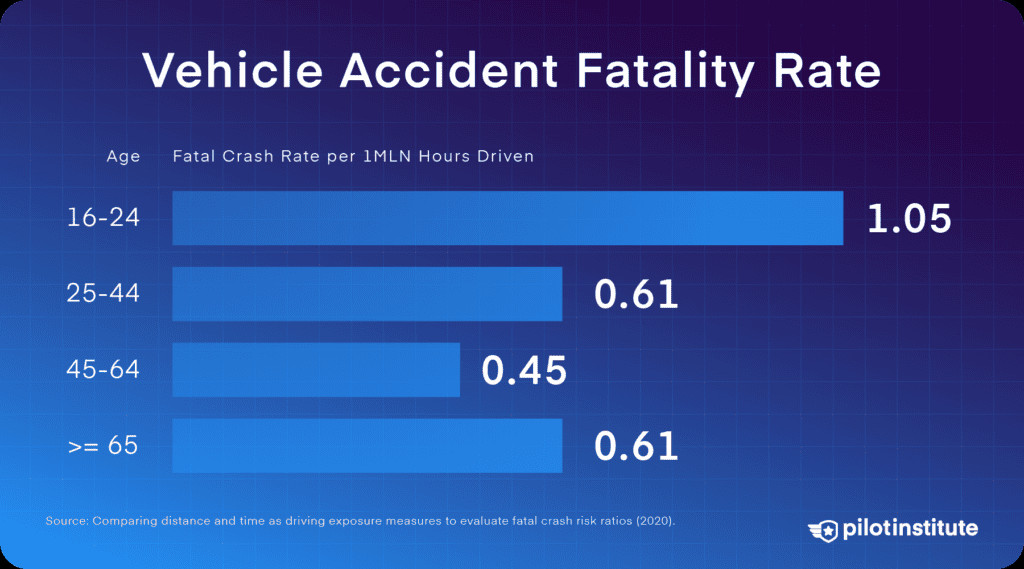 Vehicle accident fatality rate by age
Vehicle accident fatality rate by age
1.2. How Safe is General Aviation (GA) Compared to Driving?
General Aviation (GA) encompasses all flying activities other than military and scheduled airline services. To evaluate its safety, we need to consider overall GA, personal flights, and instructional flights separately.
1.2.1. Overall GA Accident Rates
According to the NTSB, in 2021, there were 0.95 fatal GA accidents per 100,000 flight hours, which translates to 9.5 fatal crashes per million flight hours. This rate is approximately 14 times higher than the driving fatality rate.
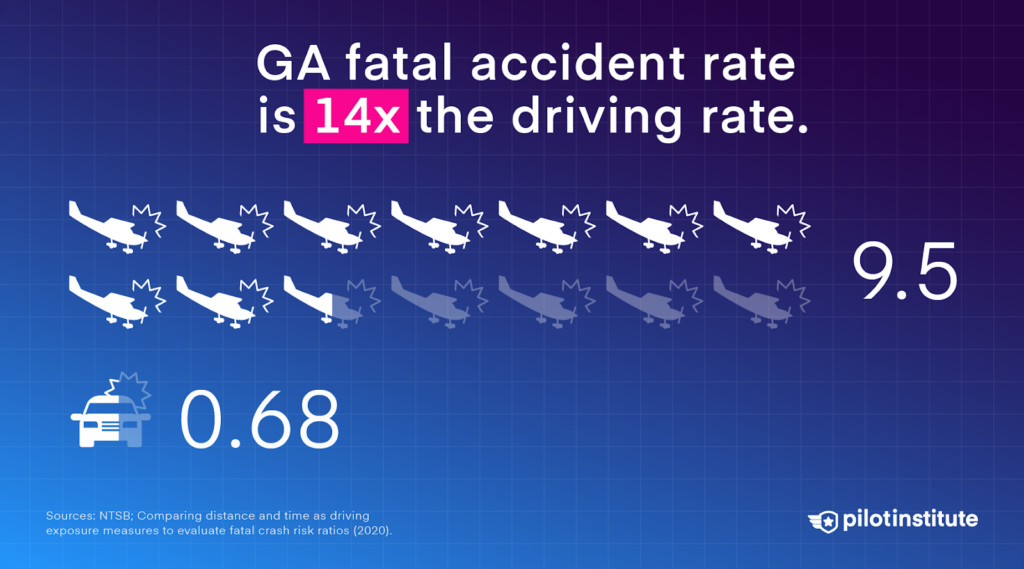 The GA fatal accident rate is roughly 14 times that of driving
The GA fatal accident rate is roughly 14 times that of driving
1.2.2. Personal Flights: The Riskiest Category
Personal flights, which include recreational flying and family trips, account for a significant portion of GA accidents. Between 2012 and 2021, this segment saw 21.1 fatal accidents per million flight hours. This is over 27 times the driving fatality rate, making personal flights more dangerous than riding a motorcycle.
 Personal flights account for the majority of total GA accidents and fatalities
Personal flights account for the majority of total GA accidents and fatalities
1.2.3. Instructional Flights: A Safer Option
Instructional flights have a much lower accident rate, with 2.3 fatal accidents per million flight hours. This is only 3.4 times more dangerous than driving, highlighting the safety benefits of structured training environments and supervised operations.
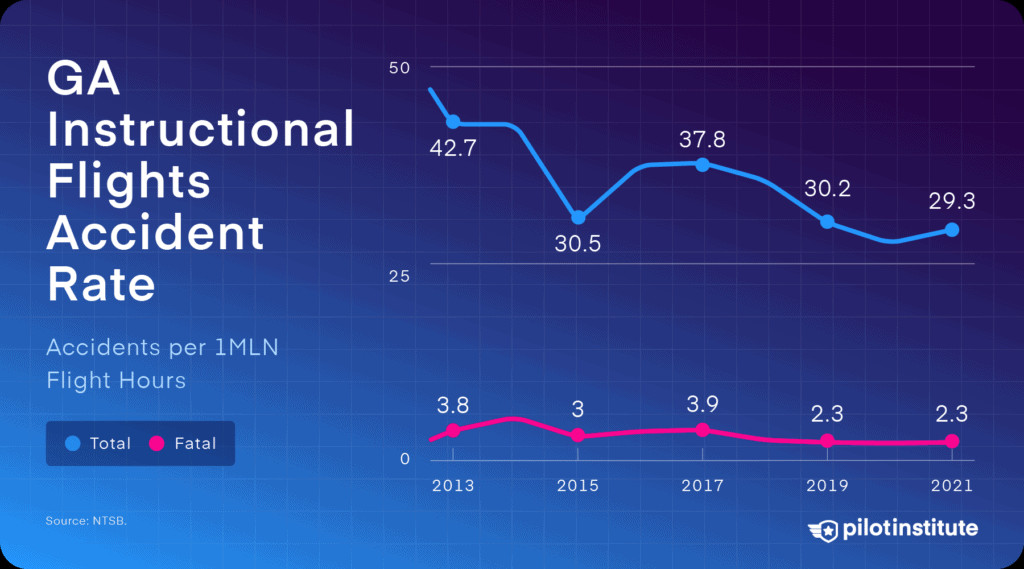 GA instructional flights accident rate: 2012-2021
GA instructional flights accident rate: 2012-2021
1.3. What Makes Corporate Aviation Safer?
Corporate aviation, involving business jets, demonstrates a relatively safe profile with only 0.48 fatal accidents per million flight hours between 2012 and 2021. This lower rate can be attributed to stringent maintenance protocols, highly trained pilots, and professional operational standards.
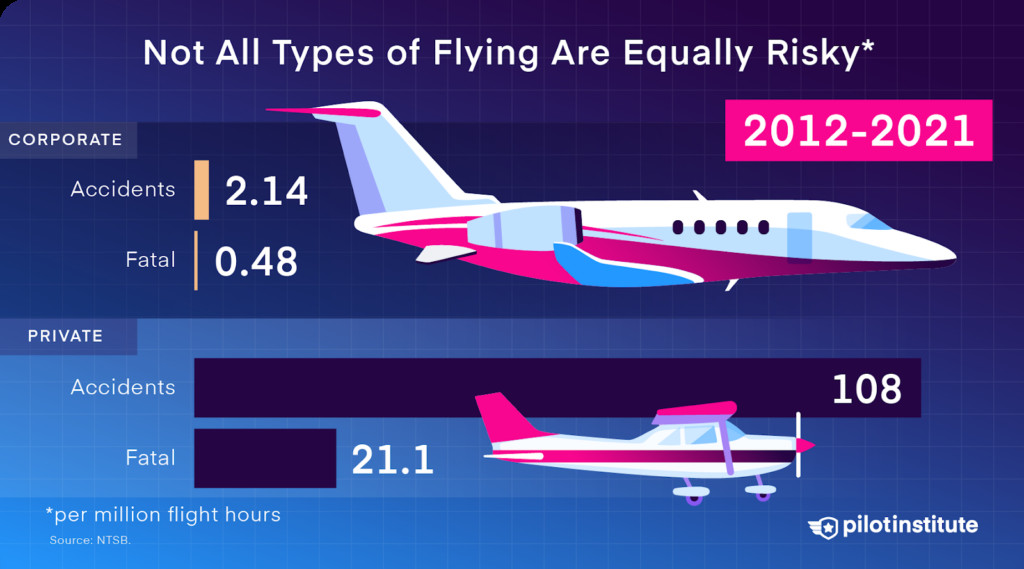 Corporate GA flying is quite safe compared to private flights
Corporate GA flying is quite safe compared to private flights
2. What Are the Key Factors Contributing to GA Accidents?
Understanding the causes of GA accidents is crucial for developing effective prevention strategies. Accidents are broadly categorized into pilot-related, mechanical, and other/unknown causes, as outlined in the AOPA’s Richard G. McSpadden Report.
2.1. How Do Unknown Causes Affect Aviation Safety?
In 2021, 15% of all accidents and 28% of fatal ones had no clear cause. These incidents are particularly challenging as they prevent learning and the implementation of targeted safety measures.
2.2. What Role Do Mechanical Issues Play in GA Accidents?
Mechanical failures account for about 16% of all GA accidents but only 7% of fatal ones in 2021. The engine is the most significant contributor to these issues. Surprisingly, only six out of 57 engine failures reported in 2021 were fatal, suggesting that many engine-related emergencies are manageable.
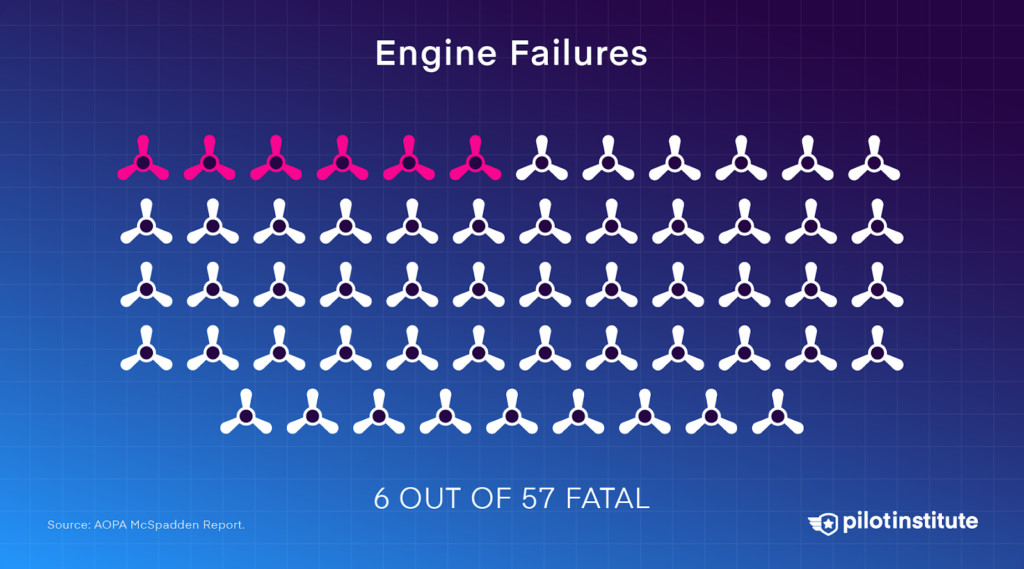 Six out of 57 engine failure accidents in 2021 were fatal
Six out of 57 engine failure accidents in 2021 were fatal
2.2.1. Common Causes of Engine Failures
AOPA’s analysis reveals that 30% of engine failures have no clear cause, while maintenance issues account for 16%, and structural failures for 17%. Preventable problems like carburetor ice or fuel issues make up the remainder. This indicates that pilots and mechanics contribute to about half of all engine failures.
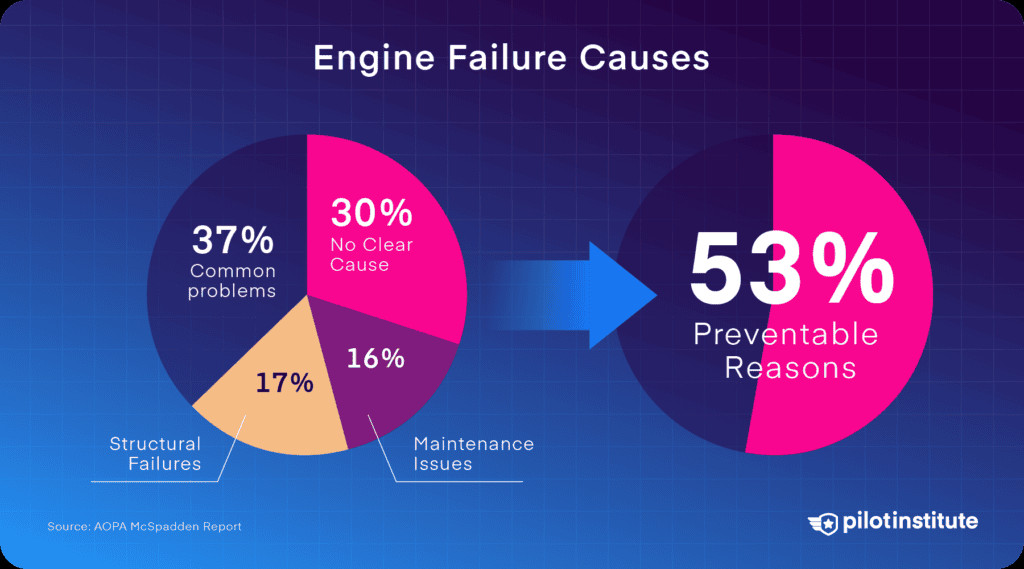 A diagram depicting the reasons for engine failures
A diagram depicting the reasons for engine failures
2.2.2. The Impact of Fuel Management on Safety
Fuel-related accidents can occur due to fuel contamination (water in the tank), fuel starvation (fuel not reaching the engine), or fuel exhaustion (running out of fuel). Fuel exhaustion is often a result of poor flight planning, highlighting the importance of meticulous preparation.
 Types of GA fuel management accidents
Types of GA fuel management accidents
2.3. Why Is Pilot Error the Leading Cause of GA Accidents?
Pilot-related accidents remain the most significant factor in GA incidents. In 2021, the pilot was deemed at fault in 69% of all GA accidents, emphasizing the critical role of human factors in aviation safety.
2.3.1. What Is Loss of Control In-Flight (LOC-I)?
Loss of control in-flight (LOC-I) is the most common and fatal defining event in GA accidents. It typically involves the pilot losing control of the aircraft due to factors such as flying too slow or making uncoordinated control inputs. Stalls and spins in the traffic pattern during maneuvering flight are particularly dangerous and often unrecoverable.
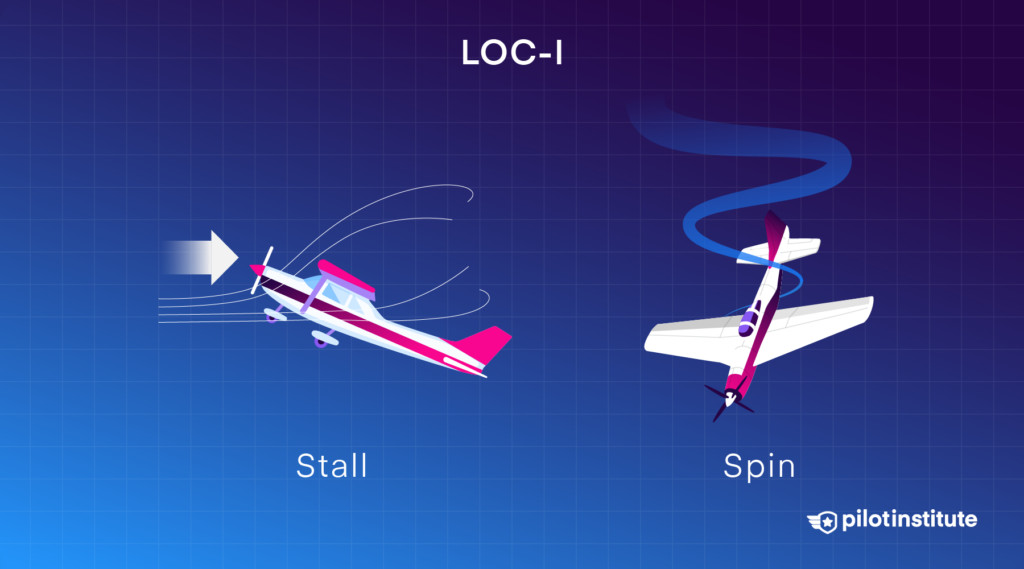 Loss of Control In-Flight: the leading cause of fatal accidents
Loss of Control In-Flight: the leading cause of fatal accidents
2.3.2. How Do Landing Accidents Occur?
Many GA accidents happen during landing, although these are not typically the most fatal. The most common landing accident involves loss of control.
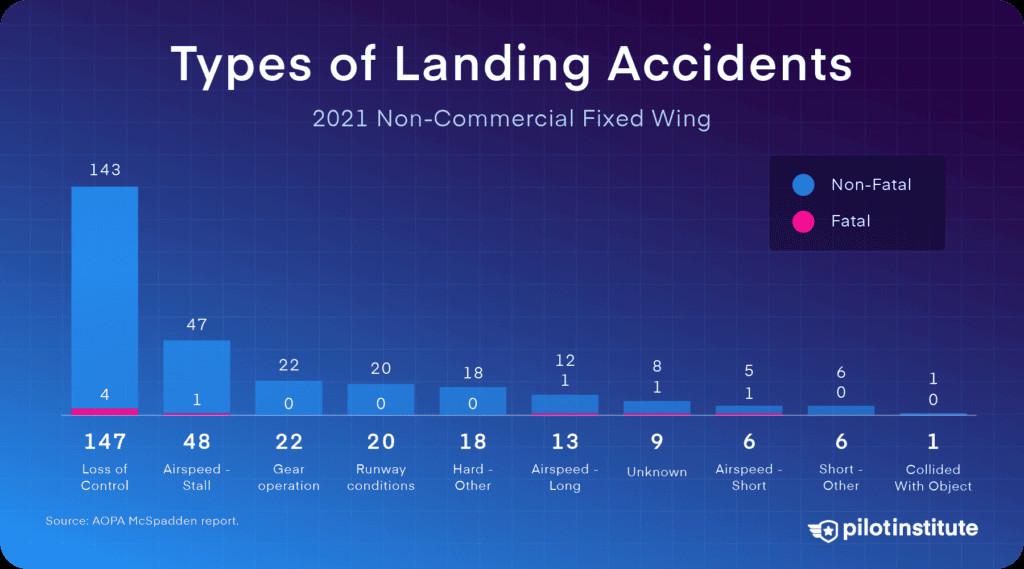 Types of GA landing accidents
Types of GA landing accidents
2.3.3. Why Are Takeoff and Climb Accidents So Dangerous?
Takeoff and climb accidents have a higher fatality rate because the aircraft is in a low-energy, low-altitude state with a high angle of attack, leaving little margin for error. Stalls are particularly deadly during these phases of flight.
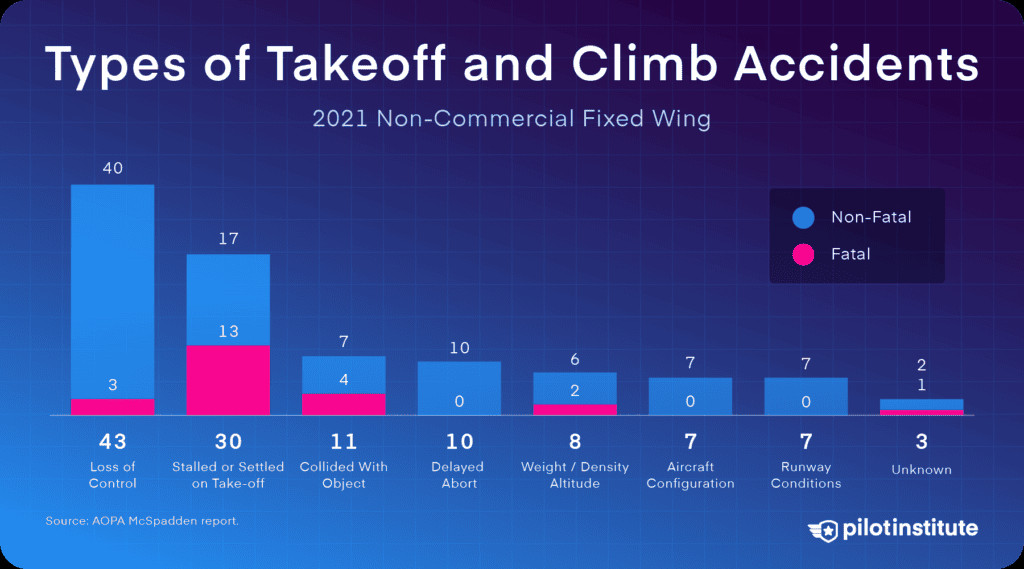 Types of GA takeoff and climb accidents
Types of GA takeoff and climb accidents
2.3.4. What Is Controlled Flight Into Terrain (CFIT)?
Controlled Flight Into Terrain (CFIT) is an unintended collision with the ground or an obstacle, often resulting from a loss of situational awareness or attempts to descend below minimums during instrument procedures.
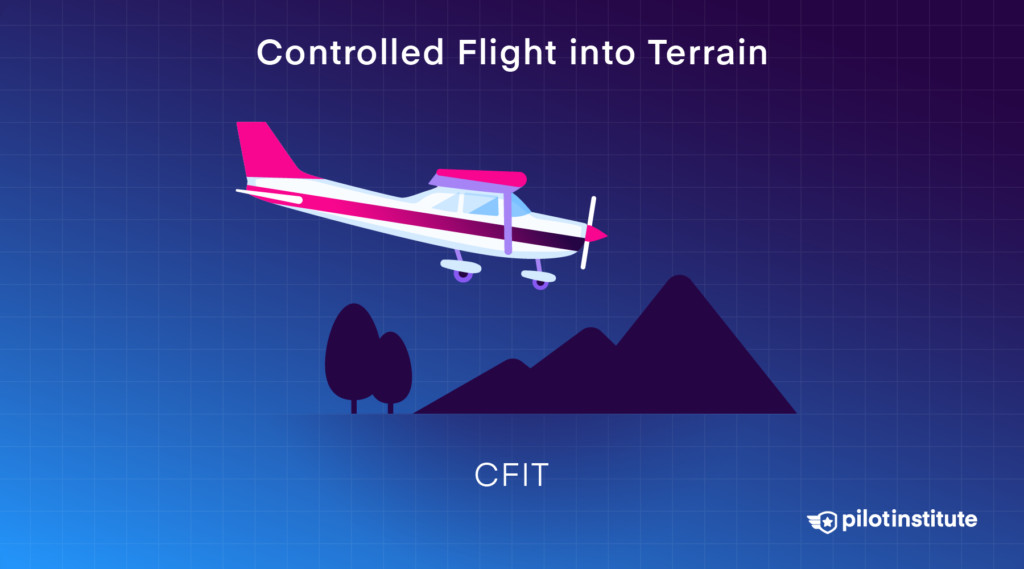 Controlled Flight into Terrain: a top cause of fatal accidents
Controlled Flight into Terrain: a top cause of fatal accidents
2.3.5. The Dangers of Unintended VFR Flight into IMC
Unintended VFR flight into instrument meteorological conditions is another avoidable cause of accidents. Flying visually into clouds or low visibility had a 71% fatality rate in 2021, highlighting the critical importance of avoiding such conditions.
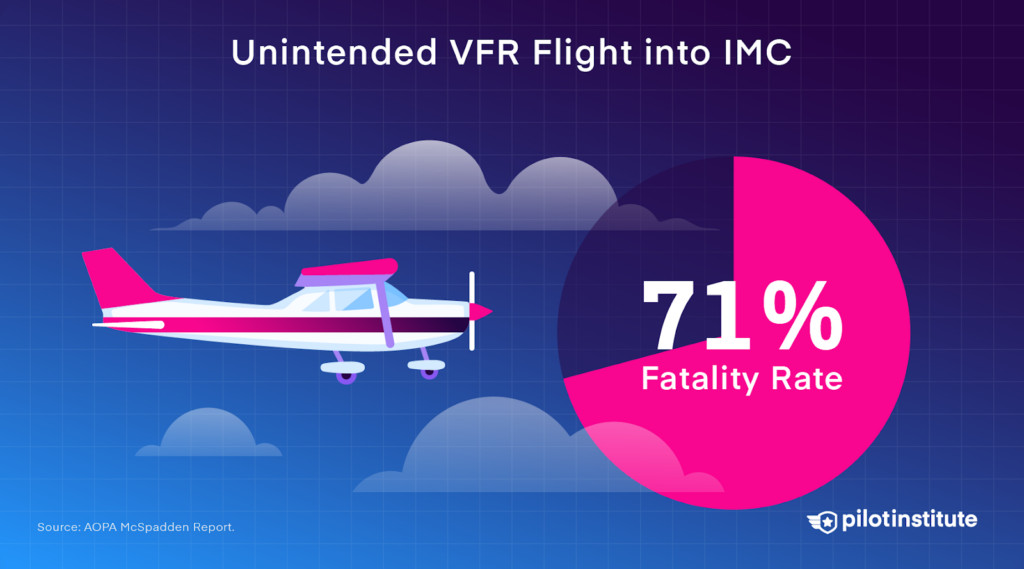 Unintended VFR flight into IMC has a 71% fatality rate
Unintended VFR flight into IMC has a 71% fatality rate
3. Enhancing Safety: Best Practices and Preventative Measures
While general aviation flying may never be as safe as driving, implementing safety measures and adhering to best practices can significantly reduce risk.
3.1. What Can Be Learned From Instructional Flights?
The lower fatality rate in instructional flights can be attributed to several factors:
- Supervised environment: Flights occur under the guidance of experienced instructors.
- Structured operations: Flight schools maintain highly structured and risk-averse environments.
- High maintenance standards: Instructional airplanes undergo frequent inspections.
- Proficient instructors: Instructors tend to be more proficient than private pilots who fly less frequently.
These factors mirror the safety principles of airline travel, which is characterized by structured operations, risk aversion, and highly trained pilots.
3.2. How Can Pilots Improve Their Proficiency?
Pilots can enhance their safety by:
- Staying current: Meeting all legal requirements for flying.
- Maintaining proficiency: Going above and beyond the legal minimums through continuous training and practice.
- Modeling a safety mindset: Adopting the structured and risk-averse approach of instructional and airline operations.
4. Where Can You Find Resources to Enhance Your Aviation Knowledge and Safety?
Flyermedia.net offers a wealth of resources to help pilots and aviation enthusiasts enhance their knowledge and safety. From flight training information to aviation news and career opportunities, flyermedia.net is your go-to source for all things aviation.
4.1. What Flight Training Resources Does Flyermedia.net Offer?
Flyermedia.net provides a comprehensive directory of flight schools in the USA, detailed information on pilot certifications, and expert advice on flight training best practices. Whether you’re a student pilot or an experienced aviator, our resources can help you stay current and proficient.
4.2. How Does Flyermedia.net Keep You Updated on Aviation News?
Stay informed about the latest aviation news, safety updates, and technological advancements with flyermedia.net. Our team of aviation experts curates the most relevant and timely information to keep you ahead of the curve.
4.3. What Career Opportunities Are Available in the Aviation Industry?
Explore a wide range of career opportunities in the aviation industry through flyermedia.net. From pilot positions to aviation maintenance and engineering roles, we connect you with top employers and provide resources to help you achieve your career goals.
5. Maximizing Safety in General Aviation: A Proactive Approach
To enhance safety in general aviation, a proactive approach is essential. This involves not only adhering to regulations but also continuously seeking ways to improve proficiency and mitigate risks.
5.1. What Are the Essential Pre-Flight Checks?
Performing thorough pre-flight checks is critical to identifying potential issues before takeoff. This includes:
- Inspecting the aircraft for any mechanical issues.
- Checking fuel levels and ensuring there is no contamination.
- Reviewing weather conditions and ensuring they are suitable for the flight.
- Verifying that all necessary documents and equipment are on board.
5.2. How Can Pilots Improve Their Decision-Making Skills?
Effective decision-making is crucial for safe flight operations. Pilots should:
- Assess risks objectively and avoid impulsive decisions.
- Consider all available information before making a decision.
- Be willing to abort a flight if conditions are not safe.
- Learn from past experiences and continuously refine their decision-making process.
5.3. The Importance of Continuous Learning and Training
The aviation industry is constantly evolving, with new technologies and procedures being introduced regularly. Pilots must commit to continuous learning and training to stay up-to-date and maintain their proficiency. This includes:
- Attending regular refresher courses and seminars.
- Participating in flight simulations and emergency procedure training.
- Staying informed about the latest aviation regulations and best practices.
6. Safety Technologies and Innovations in General Aviation
Advancements in technology have significantly enhanced safety in general aviation. From advanced avionics to improved navigation systems, these innovations are helping pilots make safer and more informed decisions.
6.1. What Are the Benefits of Modern Avionics Systems?
Modern avionics systems provide pilots with a wealth of information, including:
- Real-time weather updates.
- Precise navigation data.
- Enhanced situational awareness through electronic flight displays.
- Automated flight control systems to reduce workload.
6.2. How Does ADS-B Enhance Aviation Safety?
Automatic Dependent Surveillance-Broadcast (ADS-B) is a surveillance technology that enhances aviation safety by providing:
- More accurate tracking of aircraft positions.
- Improved situational awareness for pilots and air traffic controllers.
- Real-time traffic alerts to prevent collisions.
6.3. The Role of Flight Data Monitoring (FDM) in Improving Safety
Flight Data Monitoring (FDM) involves analyzing data from flight recorders to identify potential safety issues and improve operational procedures. This helps in:
- Detecting deviations from standard operating procedures.
- Identifying areas where pilots may need additional training.
- Monitoring aircraft performance and identifying potential maintenance needs.
7. Regulatory Oversight and Compliance in General Aviation
Regulatory agencies play a crucial role in ensuring safety in general aviation. Compliance with regulations and adherence to safety standards are essential for all pilots and aviation operators.
7.1. What Are the Key Regulations Governing General Aviation?
The Federal Aviation Administration (FAA) sets the regulations governing general aviation in the United States. These regulations cover a wide range of topics, including:
- Pilot certification and training.
- Aircraft maintenance and inspection.
- Flight operations and procedures.
- Airspace management.
7.2. How Does the FAA Enforce Safety Regulations?
The FAA enforces safety regulations through:
- Regular inspections of aircraft and aviation facilities.
- Audits of flight operations and training programs.
- Investigations of accidents and incidents.
- Imposition of penalties for violations of regulations.
7.3. The Importance of Voluntary Safety Programs
In addition to regulatory oversight, voluntary safety programs play a crucial role in improving safety in general aviation. These programs encourage pilots and aviation operators to:
- Report safety concerns without fear of reprisal.
- Share best practices and lessons learned.
- Participate in safety audits and assessments.
8. Mitigating Risks: Practical Tips for Pilots
Mitigating risks in general aviation requires a combination of knowledge, skill, and a proactive safety mindset. Here are some practical tips for pilots:
8.1. How to Conduct a Thorough Weather Briefing
A thorough weather briefing is essential for safe flight operations. Pilots should:
- Obtain a comprehensive weather briefing from a qualified source.
- Pay attention to potential hazards, such as thunderstorms, icing, and turbulence.
- Understand the limitations of their aircraft and their own abilities in different weather conditions.
- Be prepared to delay or cancel a flight if the weather is not suitable.
8.2. Best Practices for Flight Planning
Effective flight planning is crucial for ensuring a safe and successful flight. Pilots should:
- Carefully plan their route, taking into account weather conditions, terrain, and airspace restrictions.
- Calculate fuel requirements and ensure they have sufficient reserves.
- Identify alternate airports in case of unexpected diversions.
- Notify air traffic control of their flight plan and any changes to it.
8.3. Strategies for Managing Fatigue
Fatigue can impair judgment and reaction time, increasing the risk of accidents. Pilots should:
- Get adequate rest before a flight.
- Avoid flying when they are feeling tired or unwell.
- Take regular breaks during long flights.
- Be aware of the symptoms of fatigue and take appropriate action if they experience them.
9. Overcoming Common Challenges in General Aviation Safety
Despite advancements in technology and improved safety practices, several challenges remain in general aviation safety.
9.1. Addressing the Issue of Pilot Complacency
Pilot complacency can lead to a decline in situational awareness and an increased risk of errors. To combat complacency, pilots should:
- Continuously challenge themselves and seek opportunities to improve their skills.
- Maintain a healthy level of skepticism and avoid overconfidence.
- Be aware of the potential for errors and take steps to prevent them.
9.2. Enhancing Safety Culture in Aviation Organizations
A strong safety culture is essential for creating a safe and reliable aviation operation. Aviation organizations should:
- Prioritize safety above all else.
- Encourage open communication and reporting of safety concerns.
- Provide ongoing training and support for employees.
- Recognize and reward safe behavior.
9.3. The Role of Technology in Reducing Human Error
Technology can play a crucial role in reducing human error in general aviation. Examples include:
- Automated flight control systems that reduce pilot workload.
- Electronic flight displays that provide enhanced situational awareness.
- Warning systems that alert pilots to potential hazards.
10. Embracing a Safety-First Mindset: A Lifelong Commitment
Safety in general aviation is not just about following regulations and procedures. It’s about embracing a safety-first mindset and making a lifelong commitment to continuous learning and improvement.
10.1. Why Safety Should Always Be the Top Priority
Safety should always be the top priority in general aviation. The consequences of an accident can be devastating, not only for those involved but also for their families and communities.
10.2. The Importance of Peer Learning and Mentorship
Peer learning and mentorship can be valuable resources for pilots of all levels. By sharing experiences and learning from others, pilots can gain new insights and improve their safety skills.
10.3. How to Stay Engaged and Proactive in Aviation Safety
Staying engaged and proactive in aviation safety requires a commitment to continuous learning and improvement. Pilots should:
- Attend aviation safety seminars and workshops.
- Read aviation safety publications and websites.
- Participate in aviation safety organizations.
- Share their knowledge and experiences with others.
By embracing a safety-first mindset and making a lifelong commitment to continuous learning and improvement, pilots can help make general aviation safer for themselves and others. Visit flyermedia.net to discover more about flight training, aviation news, and career opportunities in the aviation industry. Contact us at Address: 600 S Clyde Morris Blvd, Daytona Beach, FL 32114, United States. Phone: +1 (386) 226-6000 or explore our website at flyermedia.net.
FAQ: Is Flying More Dangerous Than Driving?
1. Is flying in a commercial airline safer than driving a car?
Yes, flying in a commercial airline is statistically much safer than driving. Commercial airlines have stringent safety regulations, highly trained pilots, and comprehensive maintenance programs.
2. Is general aviation (GA) flying as safe as commercial aviation?
No, general aviation (GA) flying is not as safe as commercial aviation. GA flights have a higher accident rate due to factors such as less stringent regulations, varying pilot experience levels, and diverse operational conditions.
3. What makes personal GA flights more dangerous than driving?
Personal GA flights have a higher accident rate due to factors such as less structured operations, varying pilot proficiency, and recreational flying activities that may involve higher risk-taking.
4. Why are instructional flights safer than personal GA flights?
Instructional flights are safer due to the supervised environment, structured training programs, high maintenance standards for training aircraft, and the presence of experienced flight instructors.
5. What are the primary causes of GA accidents?
The primary causes of GA accidents include pilot error, mechanical failures, and unknown causes. Pilot error, particularly loss of control in-flight, is the leading cause.
6. How does pilot error contribute to GA accidents?
Pilot error can manifest in various ways, including loss of control in-flight, improper decision-making, failure to adhere to procedures, and inadequate pre-flight preparation.
7. What role do mechanical issues play in GA accidents?
Mechanical issues account for a significant percentage of GA accidents. Common mechanical problems include engine failures, fuel system issues, and structural failures.
8. How can pilots reduce the risk of GA accidents?
Pilots can reduce the risk of GA accidents by maintaining proficiency through continuous training, adhering to safety best practices, conducting thorough pre-flight checks, and making informed decisions based on weather conditions and aircraft limitations.
9. What safety measures can aviation organizations implement to improve GA safety?
Aviation organizations can enhance safety by fostering a strong safety culture, encouraging open communication, providing ongoing training, and implementing voluntary safety programs.
10. How does technology improve safety in general aviation?
Technology improves safety in general aviation through advanced avionics, ADS-B systems, and flight data monitoring, which provide real-time data, enhance situational awareness, and help prevent accidents.